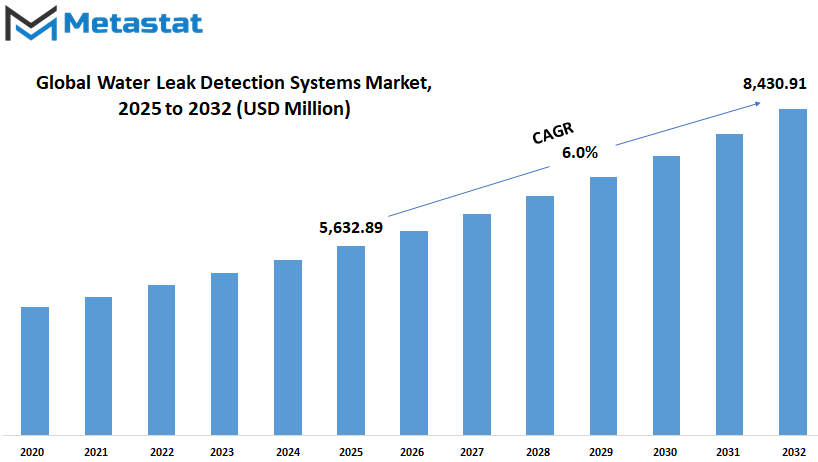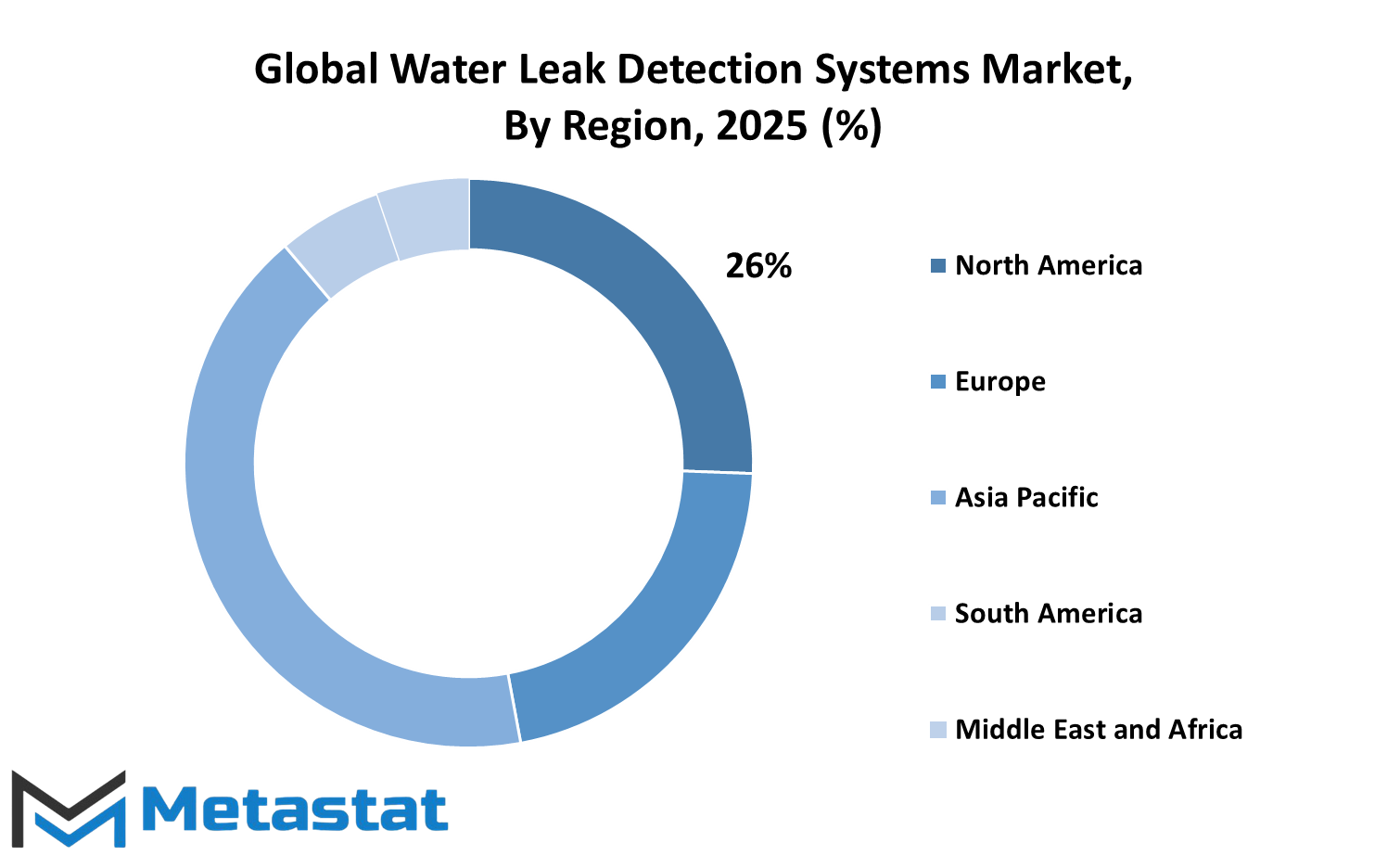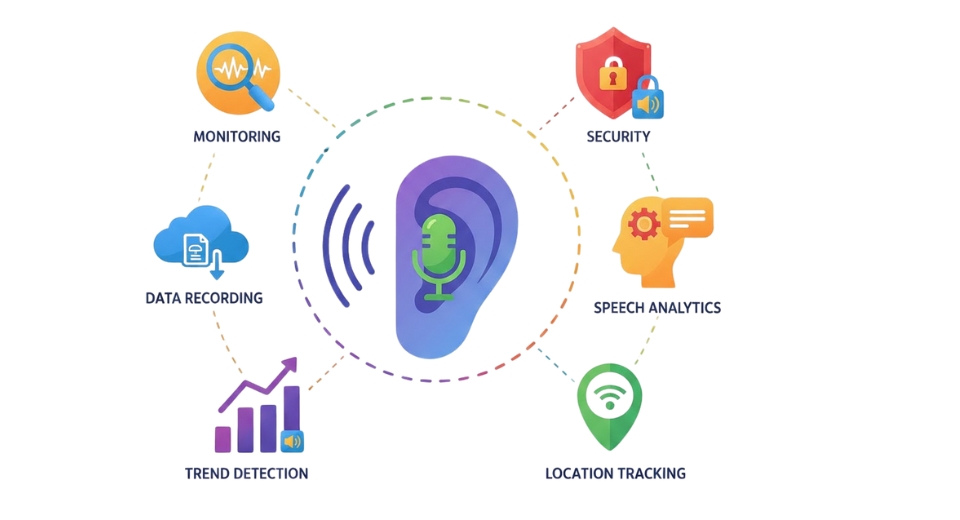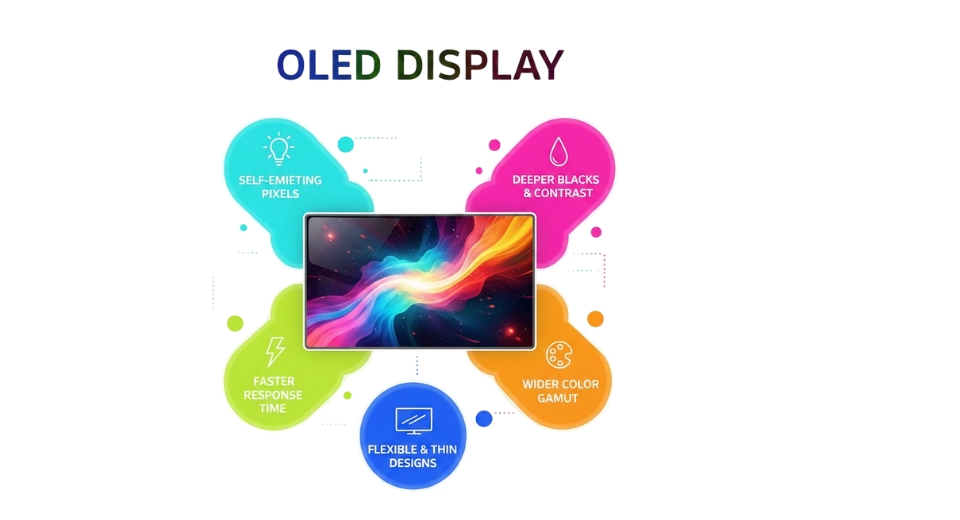MARKET OVERVIEW
The global water Leak Detection Systems market is a niche segment of the environmental monitoring and safety industry. This market deals with technologies that detect, assess, and repair water leaks in residential, commercial, industrial, and municipal settings. With increasing awareness of water conservation and infrastructure's safety, this market demand for successful detection systems will grow tremendously.
Detection methods will be used for water leak detection systems in various units, such as in pipelines, storage, and distribution. These would include acoustic sensors, ultrasonic detectors, pressure monitoring, and infrared technology, each tested for accurate leak detection. Also, future advancements and strengthening of IoT and smart technology are considered major game-changers for the Global Water Leak Detection Systems Market.The level of efficiency and on-time response to leak incidences in these systems would be enhanced with Cloud integration and real-time monitoring, thus becoming a one-stop solution for the leak management process.
This market will address the specific and unique needs of different sectors. Such systems in residential applications would prevent property damage and minimize water wastage. In great commercials, it works by keeping businesses flowing without disruptions caused by leaks. Industrial facilities utilize advanced detection technologies to protect their processes, facilities, and assets. At the municipal level, large-scale monitoring will be conducted to protect public water supplies, thus ensuring a reduction in non-revenue water losses.
Geographically, the Global Water Leak Detection Systems market runs in both developed and developing regions. Developed countries having older infrastructure will prefer advanced detection technologies to avert costly repairs and service interruptions. In comparison, the developing areas will focus more on affordable and scalable solutions for water scarcity and infrastructure development problems.
Technology innovation is an important driver for the evolution of the market. This will help bring predictive powers to detection systems through the application of artificial intelligence and machine learning algorithms, allowing proactive maintenance and timely intervention. By wireless communication and smart sensors, remote monitoring will be enabled, thus leading to decreased manual inspection and reduced operational cost. The markets would also encourage sustainable materials and energy-efficient technologies as part of global sustainability initiatives.
Regulations and standards in the industry will also determine how these technologies will be adopted in the market. The government and other regulatory bodies will impose stringent policy measures designed to enhance the adoption of leak-detection technologies to conserve our water resources and, in turn, protect public health. Conformity with these policies will ensure innovation thrives, leading to the development of systems that can be trusted and verified.
The future of the Global Water Leak Detection Systems market will be influenced by collaborative mechanisms involving various stakeholders: technology providers, utility companies, policy-makers, and consumers. Joint ventures and strategic alliances will permit sharing of knowledge and resources for designing comprehensive solutions for specific needs. Development through water conservation and infrastructure sustainability will further enhance the market's capabilities to build and develop advanced technologies and solutions that fulfill the world's needs.
In brief, the Global Water Leak Detection Systems market will play a pivotal role in water conservation issues and infrastructure integrity within various sectors of applications. The advancement of technology in collaborations with regulation will create an arena for the market to develop new and effective solutions for the detection and management of water leaks on a global scale.
Global Water Leak Detection Systems market is estimated to reach $8,430.91 Million by 2032; growing at a CAGR of 6.0% from 2025 to 2032.

GROWTH FACTORS
The Global Water Leak Detection Systems market is poised to see major growth in the coming years. Increased urbanization and deteriorating infrastructure call for advanced leak detection technology at a higher rate. Both government and private sectors invest heavily into these systems to eliminate or minimize wastage of water and lessen maintenance costs. Other things pushing the market are increasing environmental concerns and the demand for sustainability in water management. As water becomes increasingly scarce worldwide, all priorities lie toward increased efficiency in the usage of this resource, and leak detection systems contribute significantly to this goal.
Technological advancements are pushing the Global Water Leak Detection Systems market forward. IoT devices, in combination with intelligent sensors, have completely changed the way leaks can be detected and managed. Real-time monitoring and immediate response reduce harmful consequences and increase resource conservation. Moreover, the surge in smart cities thus will boost the growth of those systems. Smart cities rely on efficient infrastructure, with water management as the most important area. Incorporating leak detection systems would make sure that cities are managed effectively, minimizing wastage.
However, there are some final challenges which will restrict the growth of the market. High installation and maintenance costs for advanced detection systems can sometimes inhibit the adoption of such systems by smaller organizations, especially in developing countries where budgets tend to be tight. Another very important barrier to entry into the new technology market is the difficulty of integrating new systems with existing infrastructure. Most legacy systems were not built to be compatible with modern leak detection technology and require extensive astoundingly expensive, and time-consuming retrofitting.
However, the above challenges hold good for the future of the Global Water Leak Detection Systems market. Thus, it is highly likely that the increased awareness about the importance of saving water will bring about increased regulations and incentives from the governments for more adoption of leak detection systems. Technology advancements are expected to be a factor that makes systems more affordable for potential customers. Innovations like wireless sensors and AI-based analytics may greatly simplify this process for faster, cheaper, and more effective solutions.
The Global Water Leak Detection Systems market is currently on the steady growth path by technological advancement as well as the critical need for sustainable water management. Here, investment will pay off for the future because costs and integration problems are only important now. With the evolution of technology and growing awareness, there are chances that the market will escalate greatly, providing numerous opportunities to both businesses and governments.
MARKET SEGMENTATION
By Product Type
The Global Water Leak Detection Systems market is gaining huge traction based on the rising concern for water conservation and maintenance of infrastructure. The growth in this market is coming from technology advancement and the need for efficient water management systems emerging from different sectors. As of 2024, this market is valued at USD 2,984.97 million, from a previous value of USD 2,340.52 million. Such a trend is projected to continue, with industries, governments, and residential construction adopting more advanced solutions to tackle leakage problems.
Water leak detection systems are employed to locate leaks and fix them before they cause enormous damage or result in considerable water wastage. By Product Type, the market is further divided into active water leak detectors and passive water leak detectors. Active water leak detectors automatically stop water supply when a leak is detected, thereby taking immediate action to potential hazards.
Such a system is highly suitable for industries and large-scale commercial buildings where extensive losses due to water would happen due to leaks. On the other hand, passive water leak detectors make use of alarms and notifications to warn users of moisture detection. These would be commonly found in domestic premises and smaller commercial areas that do not need an immediate shut-off but require some early warning.
In coming years, the number of such installations in the Global Water Leak Detection Systems market is increasing because of the growing awareness of possible environmental threats and even stricter regulations on water usage. IoT (Internet of Things) and AI (Artificial Intelligence) technological developments will also be foundational to these changing aspects in the market.
Smart water leak detectors that help in communicating with home automation systems or those which send real-time alerts to smartphones are becoming more and more popular. Such advancements not only add further convenience to detection but also offer enhanced users with better management regarding the prevention of the damages from leaks.
In addition, it will be driven by an increased awareness among consumers and companies of the financial consequences of water leaks. Repairs can be expensive due to the damage caused by water and often raise utility bills; this is a good investment for leak detection systems. In addition, many insurance companies have started offering discounts for the installation of such devices.
Strikingly bright is the perceived future in terms of growth for the Global Water Leak Detection Systems market. With the market valued at nearly USD 2,984.97 million in 2024, there is, without doubt, a clear indication of increased significances in the future. It's under these major transformations in technologies as well as intensified pressures towards sustainable water management that both active and passive water leak detectors will come to play a very important role as agents of water loss prevention and protection of infrastructure globally.
By Technology
The Global Water Leak Detection Systems market will soon grow very rapidly because of advancements in technology and ongoing water conservation efforts worldwide. The demand for better water loss management will prompt a timely adoption of these systems for their ability to help minimize water loss, reduces damage, and ensures environmental sustainability. Some key technologies playing an important role in the market are Acoustic Sensors, Pressure-based Sensors, Ultrasonic Sensors, Optical Sensors, and so on.
Acoustic Sensors detect water leaks from pipelines by the sound of escaping water and are thereby widely used to detect water leaking from these pipelines. The way these sensors work is by listening and capturing sound waves through specialized devices, thus pinpointing the leak with remarkable accuracy. By virtue of the aging urban infrastructure and expansion of networks, the acoustic technology is more likely to see its installations in the increasing number, giving a solution which is reliable and cost-effective to the utilities and municipalities.
In contrast, Pressure-based Sensors work by monitoring changes in water pressure inside pipelines. A sudden pressure drop usually indicates the presence of a leak, which is quickly detected and addressed. This procedure is especially applicable for any large-scale industrial instance where the consistent maintenance of water pressure is important for an operation.
Ultrasonic sensors add yet another layer of sophistication to the Global Water Leak Detection Systems market. The high-frequency sound waves used by these sensors can therefore detect even the tiniest of leaks, making them fitting for sensitive environments wherein water damage can cause significant financial loss. Their non-invasive nature allows for easy installation and maintenance, thus furthering adoption. Optical Sensors, meanwhile, work by the principles of light-based technology to detect moisture and leaks. The sensors can detect that the environment has changed in some way that indicates the presence of water, thus operating a highly proactive and effective way of leak detection in both residential and commercial spheres.
The entrance of other innovative technologies in the market will give rise to more advanced leak-detection and water-leakage-management methods. The advancement in wireless communication and data analytics has enhanced the capability of these systems allowing real-time monitoring and accurate detection of leaks. Smart cities of tomorrow would see the integration of water leak detection systems with other smart infrastructures, thus enhancing the overall management of water and reducing wastage.
Technological advancements along with increasing awareness of conserving water will greatly benefit the Global Water Leak Detection Systems market in the years to come. The demand for viable leak detection will grow as sustainable practices become more valuable to governments and industries, thereby fuelling further innovation and growth in the market. This growth will protect society's precious water resources while also cutting costs incurred during water loss and damage, propelling forward a sustainable community future across the globe.
By End-User
The global water leak detection systems market would considerably profit due to water conservation. It is becoming increasingly important on the global scene, especially with a rising awareness of environmental sustainability and an even greater demand for efficient water management in the various end-user sectors. By end-use industry, the market will be categorized into residential, commercial, and industrial segments, each showing different growth patterns and future potential.
The residential segment consists of water leak detection systems that will provide preventive measures, as homeowners are likely to buy them to prevent incurring heavy water bills and damaging their properties. Smart home technology will drive such use, with advancement in its sensors and real-time alerts, so that the occupant will be able to act quickly before the threat becomes excessive. With increasing urbanization and expansion of housing developments, the demand for effective and affordable leak detection solutions will continue to grow over the coming years. Novel innovations such as automated shut-off valves and smartphone integration afford more attraction to homeowners sometime in the future.
The commercial segment also appears to be positively impacting the Global Water Leak Detection Systems market. Those large office buildings, shopping malls, and public facilities really have to possess efficient water management systems to continue with everyday routine operations without damaging the premises from water leaks. A small water leak in a business often results in a great deal of financial loss which can account for reparations, downtimes, and possibly legal liabilities.
Many companies will have adopted higher quality systems in leak detection technology, safeguarding their assets, and keeping operations smooth on a daily basis. From this point on, commercial properties will have to undergo modernization in most sophisticated standards; AI powered online monitoring systems provide real time data analytics, helping to quicken response to and avoidance of maintenance.
Such a chunk of the market is the industrial segment. With huge volumes of water applied in almost every process of factories, manufactured plants, and all types of industrial facilities, a minor leakage can be a cause for total production stoppage, equipment damage, and a safety risk to workers. Most industries are adopting water leak detection systems to maximize operational efficiency and comply with environmental regulations. It is also likely that we shall see systems in future that are less manual, more connected, and not only detect the leak but may even predict failure events, thus helping industries minimize risks and improve sustainability efforts.
Overall, the Global Water Leak Detection Systems Market is earmarked for significant growth for every sector. With fast-evolving technologies and an increasing awareness of the need for water conservation, these systems will soon be part of the infrastructure in every modern setting-from homes to businesses to industrial sites-into the future. The future of water management will, therefore, theft-friendly be a very effective management scheme on the prevention of leaky roofs along and utilising resources as it further promotes sustainability.
|
Forecast Period |
2025-2032 |
|
Market Size in 2025 |
$5,632.89 million |
|
Market Size by 2032 |
$8,430.91 Million |
|
Growth Rate from 2025 to 2032 |
6.0% |
|
Base Year |
2024 |
|
Regions Covered |
North America, Europe, Asia-Pacific, South America, Middle East & Africa |
REGIONAL ANALYSIS
The rapidly growing Global Water Leak Detection Systems market is driven by technological advancements and the need for efficient water management. In regional perspectives, different patterns emerge that reflect the level of development, infrastructure, and environmental considerations.
In North America, the market is backed by robust infrastructure and rising awareness about water conservation. The three countries in the region-the USA, Canada, and Mexico-are dominant in the uptake of these systems because of constant infrastructure refurbishment and governmental regulation enforcing sustainable use of water. Major investments in smart technologies have been made in the USA, including adopting water leak detection systems. Canada and Mexico are also coming up in demand from the residential and industrial sectors.
Europe is another key region, with the UK, Germany, France, and Italy carrying out programs to modernize old infrastructures and limit water wastage from any remaining sources. On the other side, strict environmental policies pushed by the European Union stimulate modern technologies for the efficient management of water resources. Smart water management systems are already implemented in urban and rural areas, as pioneered by the UK and Germany. Growth is also seen in France and Italy, especially in sectors such as agriculture, where water conservation is paramount.
The Asia-Pacific region is the fastest-growing area in the Global Water Leak Detection Systems market. Major investments in infrastructure development and smart technologies are happening in countries like China, India, Japan, and South Korea. Rapid urbanization and industrialization in China are creating high demand for efficient water management solutions, while improving urban infrastructure and water scarcity are becoming issues for increased adoption in India. Meanwhile, the technological-savvy Japan and South Korea are integrating advanced detection systems into their smart city projects.
In South America, Brazil and Argentina lead the way. With worsening environmental conditions and level-headed resource management, the region anticipates decreased water loss in urban settings. The vast urban population in Brazil and the agricultural sector in Argentina have majorly influenced the uptake of water leak detection technologies.
Middle East & Africa is also expected to witness promising growth. The GCC countries, particularly Saudi Arabia and the UAE, have invested in smart infrastructure with which to combat water scarcity in arid climate regions. They are also trying to enhance water management surrounding urban and rural settings with projects aiming to minimize water wastage and efficiently ensure water supply in the region. The double whammy of public support and private sector investments are the main catalysts propelling the market in this region.
In essence, it can be said that the Global Water Leak Detection Systems market is poised to thrive in all regions. As technology continues to develop and with rising awareness regarding water conservation, these systems will play an increasingly important role in the management of that vital resource.

COMPETITIVE PLAYERS
The Global Water Leak Detection Systems market is set for significant growth over the next few years. Technological advancement in the water management system has enhanced the demand for innovation in leak detection systems. Water conservation and safe infrastructure, with their concern about scarcity, will demand more innovative leak detection systems. Companies will drive research to develop systems that provide information on quick identification and prevention of damage through real-time monitoring and automated actions.
This results in increased competition in the market as key players are always on their toes working towards bettering their offerings in this arena. Honeywell International Inc. and Siemens AG lead the way with their huge basket of resources most of which are utilized for the incorporation of cutting-edge technology into products. Most of these companies have gone ahead to invest huge amounts of resources into research and development aimed at creating more clear reliability and accurate detection systems. Another entry is that of CMR Electrical and Stanlay.
Urbanization continues to have significant effects in most parts of the globe and, consequently, also increases the demand for effective water management solutions. On this front, TTK and Aqua Leak Detection will continue to gain momentum with residential detection systems as well as large-scale infrastructure projects. Focused on user-friendliness and integration into existing building management systems, therefore, attraction multipliers for a variety of customers.
Aquilar and NEC Corporation are taking the lead by making their detection systems smarter through the use of IoT and AI technologies. So, predictive maintenance will be possible with little chances of instances of severe damage. The same way is also followed by GEESYS and Elion Technologies keeping up their operations competitive in an innovation/efficiency valuation market.
Synopsys Tech Pvt Ltd., Andel, and RLE Technologies are further important participants in the same race. Their thrust on reliability and cost effectiveness gives even a small business a chance to take advantage of improved water leak detection solutions. PermAlert and Itron, Inc., both resource-conserving and environment-friendly, work towards the world's efforts toward prevention in water conservation and environmental protection.
Detection Technologies LLC is another emerging name in the industry. It satisfies commercial and industrial clients by concentrating on the rapid detection of problems and bringing minimal maintenance. As technology progresses, it is said that these companies will introduce even more sophisticated solutions, further driving the growth of the Global Water Leak Detection Systems market.
Smart technologies will dominate this future market. The emphasis on sustainability will mark this market going forward. As competition increases in the resulting companies, innovation, efficiency, and customer-centered approaches will ensure that their products will vary. This is how the Global Water Leak Detection Systems market derives the impetus to grow massively-from the combined efforts of these active key players and persistent demand for effective water management solutions.
Water Leak Detection Systems Market Key Segments:
By Product Type
- Active water leak detector
- Passive water leak detector
By Technology
- Acoustic Sensors
- Pressure-based Sensors
- Ultrasonic Sensors
- Optical Sensors
- Other
By End-User Industry
- Residential
- Commercial
- Industrial
Key Global Water Leak Detection Systems Industry Players
- Honeywell International Inc.
- Siemens AG
- CMR Electrical
- Stanlay
- TTK
- Aqua Leak Detection
- Aquilar
- NEC Corporation
- GEESYS
- Elion Technologies
- Synopsys Tech Pvt Ltd.
- Andel
- RLE Technologies
- PermAlert
- Itron, Inc.
WHAT REPORT PROVIDES
- Full in-depth analysis of the parent Industry
- Important changes in market and its dynamics
- Segmentation details of the market
- Former, on-going, and projected market analysis in terms of volume and value
- Assessment of niche industry developments
- Market share analysis
- Key strategies of major players
- Emerging segments and regional growth potential








 US: +1 3023308252
US: +1 3023308252






